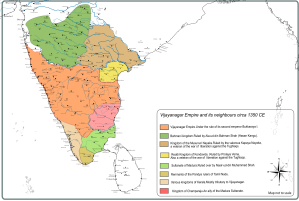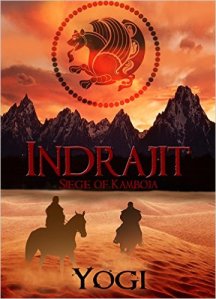This article is continued from part I.
3.Achievements’ of Bukkaraya I
3.1 Destruction of the sultanate of Madurai
As we have seen before the annihilation of the Madurai sultanate was essential to secure the rear of the newly created empire of Vijayanagara.It was also essential to succsefully defend against yhe Bahmani jihad from the north of the river Krishna.Bukkaraya moved with decisive speed and despatched his elder son Kamparaya to uproot the foothold which the Islamic jihadi’s had gained in the deep south of India.The unstructions given by Bukkaraya were clear and unambiguous as shown in this verse in the Madhuravijayam:
“ When all the forest kings are defeated then defeating the Muslim king will not be diffuclt for you.When hundreds of branches of a tree are burnt by the forest fire,is it possible that the tree trunk will not burn?” Verse 11, Eighth Canto, Madhuravijayam.
From the evidence given in the madhuravijyam it is clear that the Chola and Pandya kings who had been dispossessed by the Sultanate and its allies had taken shelter at Vijayanagar court.Madhuravijyam also hints at the fact that the kings of kerala were tributaries to Bukkaraya.
Reinforced by their allies, the Vijayanagar army issued forth from the capital city like a raging torrent.The days of the adhramic Islamic sultanate were numbered now.
“ The army which looked like the grand confluence of seven oceans began its orderly march with great uproar.” Verse 44, Fourth Canto, Madhuravijayam.
With lightening rapidity Kamparaya’s forces reached Mulbagal in a matter of six days. From Mulbagal they swept down into Tamil country and faced off the Champaraju on the Southern bank of the river Palar near Kanchipuram. In the climactic battle Champaraju’s army was shattered and he was forced to seek shelter in the fortress of Rajgambhiranmalai. Besieged and with no succor in sight Champaraju sallied forth from his stronghold and met Kamparaya in single combat, in which he met his doom at the hands of Kamparaya. After stabilizing the anarchic condition in the erstwhile Champaraju kingdom, Kamparaya moved to attack Madurai.
In this expedition he was accompanied by his Brahaman general Gopanarya (Gopanna),Saluva Mangu (who moved down from Udayagiri) and his chief minister Someya Dannayaka.The strike force under Gopana destroyed the forward Muslim garrison at Samayavarm. Srirnagam was liberated and the idol of Sri Ranganatha was reconscreated in the temple which had suffered terrible damage under the Islamic vandals. The temple of Hoysalesvara at Kannanur had been dismantled by Muslims right upto its foundations and a mosque constructed in its place. The mosque was torn down and worship restored in the temple.
For the Madurai sultanate the end game was in sight. Kamparaya fought the muslims in a ferocious battle outside Madurai.The ferocity of the fighting is illustrated in these verses from the Madhuravijayam :
“ The soldiers of Kamparaya with anger ( caused by the enemies evil deeds) avoiding the shower of enemy arrows with their shields,moved unobserved and simultaneously hacked the bodies of enemy horses along with their riders.” Verse 1, Ninth Canto, Madhuravijayam.
“ The bow men severed the trunks of enemy elephants with half moon faced arrows.They (trunks of elephants) fell down into pools of blood like serpents in the sacrificial fire of King Janmejaya.” Verse 3, Ninth Canto, Madhuravijayam.
In the hotly contested battle nearly all the Muslim commanders were killed. in desperation the Muslim sultan attacks Kamparaya and is beheaded in the ensuing encounter. Thus curtains came down on one of the darkest chapters of Indian history. For the first time in Indian history a blood thirsty sultanate was uprooted root and branch and no trace of it left, except for odd coins discovered by numismatists centuries down the road.
3.1.2 Who was the sultan and when did this war take place?
The dates for the existence and destruction of the Madurai sultanate vary widely. This is natural given the paucity of evidence and inscriptional data which can be extremely confusing. The dates for the Madurai war range from 1352 to 1371 CE, a wide range of nearly twenty years. Thus if the foundation of the Madurai sultanate is dated to 1333 CE, it could have lasted anywhere from twenty to forty years depending on which scholars argument you accept.
The table below briefly summarizes the range of dates put forward by various scholars:
| Name of Scholar |
Proposed date for the Madurai war |
Possible Ruling Sultan |
| Dr.S.K.Iyengar |
prior to 1358 CE
|
Naziruddin Mohammed Shah (1342-1352 CE) |
| K.A.N Sastri |
around 1364 CE
|
Fakhruddin Mubarak Shah*(1359-1368 CE) |
| T.V.S Pandarattar |
1364 CE
|
Fakhruddin Mubarak Shah*(1359-1368 CE) |
| Dr.T.V.Mahalingam |
1361-1363 CE
|
Fakhruddin Mubarak Shah*(1359-1368 CE) |
| Father Heras |
1377 CE
|
Alauddin Sikandar Shah* |
| V. Rangachari |
1365-1371 CE
|
Fakhruddin Mubarak Shah*,Qurbat Hasan Kangu* |
| Hayavadana Rao |
1371 CE
|
Qurbat Hasan Kangu* |
| K.R Venkataramana Iyer |
1371 CE
|
Qurbat Hasan Kangu* |
| Prof.N.Venkataramanaya |
war in two phases 1370-71 and
final resolution in 1378 |
1.Qurbat Hasan Kangu2. Alauddin Sikandar Shah* |
| Dr.A.Krishnaswami |
1371 CE
|
Fakhruddin Mubarak Shah* |
| Dr.B.A Saletore |
1371 CE
|
1.Qurbat Hasan Kangu2. Alauddin Sikandar Shah* |
3.2 Defeat of the Bahmani Jihad
The Bahmani sultan Ala-ud-din Hasan Kangu launched a major invasion in 1355-1357 CE which was successfully beaten off by Bukkaraya. The shock of the defeat and near continuous warfare with Vijayanagar virtually emptied the Bahmani treasury. On Ala-ud-din’s death in 1359 CE,his son Muhammad I found himself broke and unable to mount a credible attack against Vijayanagar. The danger of Firoze Shah Tughlaq (Sultan of Delhi) mounting an attack to recover his brothers conquests in the Deccan also loomed large. Muhammad packed off his mother with a large bribe of gold coins to the Sharif of Mecca and the impotent Abbasid caliph living in Egypt.
At this point in 1360 CE both Bukkaraya and Kapaya Nayaka of Warangal were breathing down his neck. With the tinkle of gold in his hands the Abbaisid caliph promptly issued a farman asking Feroze Tughlaq to desist from attacking the Bahmani kingdom.The farman of an impotent and powerless figurehead from the middle east was enough to convince Firoze Tughlaq to issue an assurance of non-aggression to Muhammad I. This a typical example of the mentality of Muslims in India even today where everything from the Arab world is greater than the land they live in.
Assured of safety on his northern borders Muhammad promptly launched a vicious jihad in 1361 CE against Kapaya Nayaka and Vijayanagar who were allies. On both fronts he had to suffer serious reverses. Kapaya Nayaka’s son Nagadeva captured the fort of Kaulas. Bukkaraya reinforced Kapaya Nayaka with 20,000 cavalry and a large force of infantry. The Bahmani forces had to face a humiliating defeat and the situation was so uncertain for the Bahmani’s that rumors spread of Muhammad death on the battlefield. At the end of the war Bukkaraya forced the jihadi Muhammad to agree to the following terms :
i. The river Krishna was recognized as the boundary between Vijayanagar and the Bahmani sultanate.
ii. Prisoners of war on both sides were to be set free.
iii. In future wars women and children would not be harmed and would be treated with respect.
iv. The forts of Raichur and Mudgal to be jointly controlled.
The terms of the treaty clearly indicate that the Bahmani’s had received a drubbing at the hands of Vijayanagar. This war was notable for the fact that firearms including cannons and muskets were employed by both sides.
3.3 Restoration of a traumatised society
For his untiring efforts in healing the scars inflicted on Hindu society, Bukkaraya was given the title “ Vedamarga Prasthapika” ie the re-establisher of the Vedas. His patronage revived the old systems of learning which had fallen into decay in a half century of warfare.An extremely tolerant ruler he mediated between various sects such as the Jainas and Srivaisnava’s extracting promises that they would respect each other.
It was but natural that the arts, sciences and literature would flourish under the protection of the sword wall erected by Bukkaraya.To quote from Dr.Krishnaswami’s book “ Tamil Country under Vijayanagar”,
“ The rulers of Vijayanagar restored worship in the temples, repaired old temples and towers, settled disputes amongst the temple servants and made extensive endowments in the shape of jewels,lands,taxes and other income.”
He also constructed extensive water management projects the most significant of which was the reservoir of Bukkasamudram. The old water dams, bridges etc which had fallen into ruins due to the Muslim depredations were repaired and restored. Taxes were reduced keeping in view the strained circumstances of the land.
Goa which was under the Kadamba kings came under incessant attack by the Bahmani jihadis. Under Bukkaraya the Islamic invaders were pushed out and Goa was recovered.
This great defender of Dharma breathed his last on 24th February 1377 after a glorious reign of more than twenty years.
References
1.Tamil Country under Vijayanagar rule, Dr.A.Krishnaswami,Annamalai University,1964.
2.Social and Political Life in the Vijayanagara Empire, B.A.Saletore,Vola I & II. (both are available for free download here).
3. Original translation of Madhuravijyam, to be published by Sriyogi Publications in 2013.
4.Madhuravijyam,English translation by Prof.Tiruvenkatachari,Madras University,1959.
5. Prof.N.Venkataramanayya’s articles in Vijayanagar history in Itihaas, the journal of Andhra Pradesh State Archives,vol II,no.2,1975, Prolegomena to the Study of Vijayanagar.
* These names have been solely based on numismatic evidence, they are not backed up by either inscriptional or literary sources. Prof. N.Venkataramanaya has correctly called into question the validity of taking these names and dates for granted solely based on the evidence of coins.



